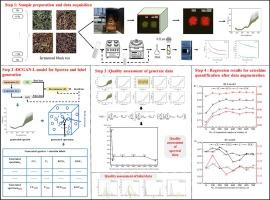用于发酵红茶中儿茶素定量的改进型深度卷积生成对抗网络。
IF 4.3
2区 化学
Q1 SPECTROSCOPY
Spectrochimica Acta Part A: Molecular and Biomolecular Spectroscopy
Pub Date : 2024-10-30
DOI:10.1016/j.saa.2024.125357
引用次数: 0
摘要
快速、无损地量化发酵红茶中的儿茶素对评价红茶质量至关重要。高光谱成像与化学计量学的结合已被应用于定量检测,但其性能通常受限于有限的数据集规模。针对儿茶素回归分析中样本不足的难题,本研究提出了一种带有标记模块的改进型深度卷积生成对抗网络,命名为 DCGAN-L,用于高光谱数据增强。DCGAN-L 由光谱生成模块和标签生成模块组成。首先生成合成光谱,并提出评估其质量的指标。然后,生成相应的标签值,包括表儿茶素没食子酸酯(ECG)、表儿茶素(EGC)、儿茶素(C)和总儿茶素(CC)。在生成标签时,首先测量合成光谱与所有真实光谱之间的欧氏距离,然后根据这些距离分配权重以计算标签值。随后,用生成的合成数据扩充训练数据集。最后,根据随机森林(RF)和广义学习系统(BLS)两种回归模型,评估了数据扩增对儿茶素定量的影响。与数据增强前的结果相比,RF 和 BLS 模型的平均 R2 分别增加了 0.044 和 0.164。所提出的 DCGAN-L 模型可以在样本量有限的情况下快速、无损地定量红茶中的儿茶素。本文章由计算机程序翻译,如有差异,请以英文原文为准。

An improved deep convolutional generative adversarial network for quantification of catechins in fermented black tea
The rapid and non-destructive quantification of catechins in fermented black tea is crucial for evaluating the quality of black tea. The combination of hyperspectral imaging and chemometrics has been applied for quantitative detection, but its performance is usually constrained by the limited dataset size. Targeted at the challenge of insufficient samples in regression analysis of catechins, this study proposes an improved deep convolutional generative adversarial network with labeling module, named as DCGAN-L for hyperspectral data augmentation. The DCGAN-L consists of the spectral and label generating modules. First the synthetic spectra were generated, and an indicator was proposed to evaluate their quality. Then, the corresponding label values were generated, including epicatechin gallate (ECG), epicatechin (EGC), catechin (C), and total catechin (CC). For label generating, the Euclidean distances between the synthetic spectrum and all true spectra were measured, followed by allocating weights for calculating the label values based on these distances. Subsequently, the training dataset was augmented with the generated synthetic data. The effect of data augmentation was finally evaluated based on two regression models of random forest (RF) and broad learning system (BLS) for the quantification of catechins. Compared with the results before data augmentation, the average R2 of RF and BLS models increased by 0.044 and 0.164, respectively. The proposed DCGAN-L model allows for the rapid, non-destructive quantification of catechins in black tea in the case of limited sample size.
求助全文
通过发布文献求助,成功后即可免费获取论文全文。
去求助
来源期刊
CiteScore
8.40
自引率
11.40%
发文量
1364
审稿时长
40 days
期刊介绍:
Spectrochimica Acta, Part A: Molecular and Biomolecular Spectroscopy (SAA) is an interdisciplinary journal which spans from basic to applied aspects of optical spectroscopy in chemistry, medicine, biology, and materials science.
The journal publishes original scientific papers that feature high-quality spectroscopic data and analysis. From the broad range of optical spectroscopies, the emphasis is on electronic, vibrational or rotational spectra of molecules, rather than on spectroscopy based on magnetic moments.
Criteria for publication in SAA are novelty, uniqueness, and outstanding quality. Routine applications of spectroscopic techniques and computational methods are not appropriate.
Topics of particular interest of Spectrochimica Acta Part A include, but are not limited to:
Spectroscopy and dynamics of bioanalytical, biomedical, environmental, and atmospheric sciences,
Novel experimental techniques or instrumentation for molecular spectroscopy,
Novel theoretical and computational methods,
Novel applications in photochemistry and photobiology,
Novel interpretational approaches as well as advances in data analysis based on electronic or vibrational spectroscopy.

 求助内容:
求助内容: 应助结果提醒方式:
应助结果提醒方式:


